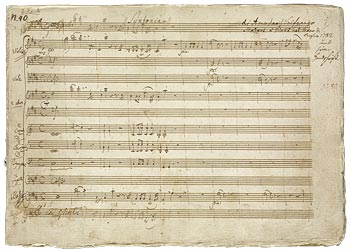
The Morgan Library & Museum celebrated the 250th anniversary of the birth of Wolfgang Amadeus Mozart (1756–1791) with an exhibition that traces Mozart's brief life through manuscripts, letters, and first editions of his works.
Mozart at 250: A Celebration began with the manuscripts of his earliest surviving compositions—four short keyboard works composed by Mozart at age five and written down by his father, Leopold—followed by his earliest dated letters, to his mother and sister, written when he was thirteen. Also on view were manuscripts of the two earliest Mozart symphonies in the repertories of major orchestras today—those in G Minor, K. 183, and A, K. 201—composed in Salzburg in the early 1770s.
Mozart traveled extensively during the first twenty-five years of his life. On view was the manuscript of his Symphony in F, K. 112, composed in 1771 during his second trip to Italy, and the dramatic Piano Sonata in A Minor, K. 310, one of his most frequently performed, written in 1778 during his second visit to Paris.
In 1781, Mozart moved from Salzburg to Vienna; except for brief trips back to Salzburg, Prague, Frankfurt, Berlin, and a few other cities, he would remain in Vienna for the last decade of his life. Among the first works he wrote after his arrival in Vienna was the Violin Sonata in F, K. 376/374d. Mozart's celebrated "Haffner" Symphony, K. 385, was performed at his first public concert in Vienna, on 23 March 1783. The autograph manuscript was shown here in the velvet and silver case in which it was housed when it was presented to King Ludwig II of Bavaria in 1865.
Other manuscripts from the Vienna years included those of the somber Fugue for Two Pianos in C Minor, K. 426, Mozart's only keyboard fugue of any distinction; two of his best-known piano concertos—in C, K. 467, and D ("Coronation"), K. 537; Der Schauspieldirektor (The Impresario), the only manuscript of a Mozart opera in this country; the Piano Rondo in D, K. 485, known to piano students around the world; the Horn Concerto in E-flat, K. 495, written in four different colors of ink; and the arrangement for voice, violin, and piano of Cherubino's aria "Non so più cosa son" from Le nozze di Figaro (The Marriage of Figaro), the only complete arrangement of an operatic number Mozart is known to have made.
The exhibition ended with the exceedingly rare first edition of the Requiem, K. 626, left incomplete at Mozart's death.
Wolfgang Amadeus Mozart (1756–1791)
Symphony in D Major, K. 385
Autograph manuscript of the "Haffner" Symphony
[1782–83]
The Mary Flagler Cary Music Collection, 1979; Cary 483
